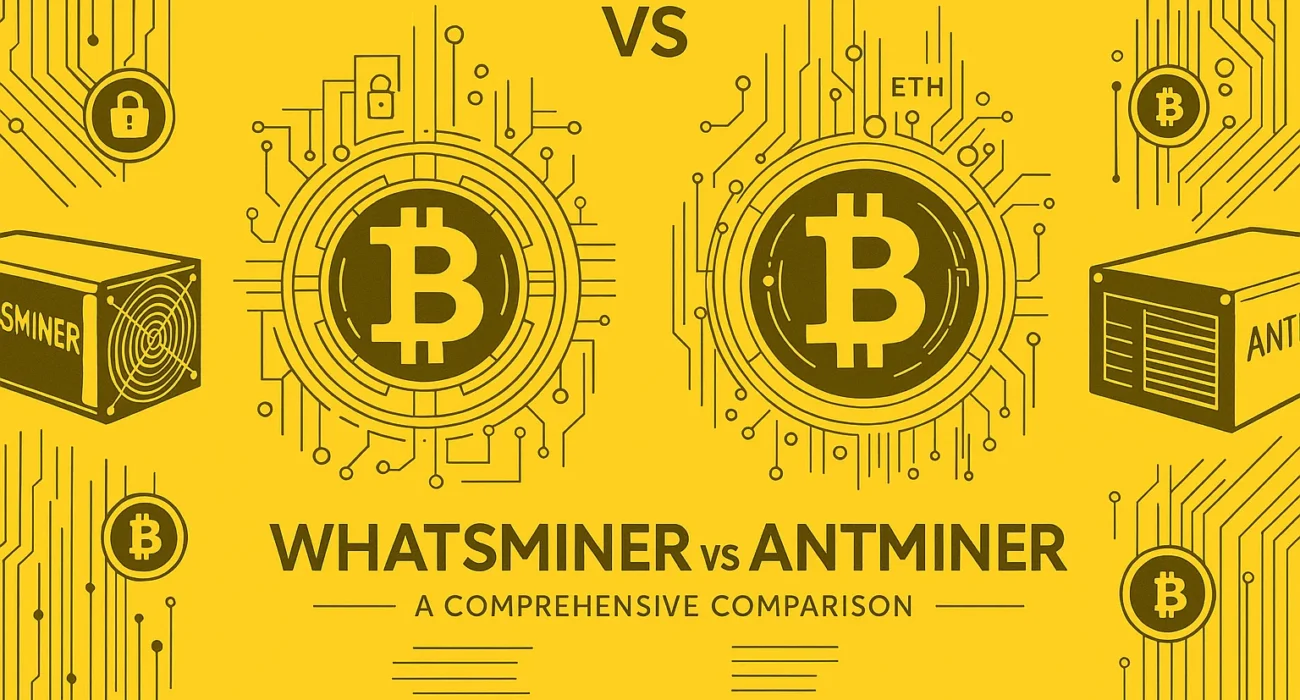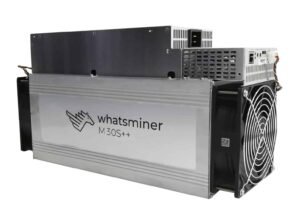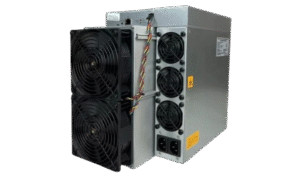Two giants dominate Bitcoin mining in 2025 — Antminer (Bitmain) and Whatsminer (MicroBT). But which is more profitable for you? Look, if you are thinking about jumping into crypto mining or maybe upgrading what you already have running, this question keeps you up at night. The battle between these two has become intense lately. Both companies keep releasing machines that somehow manage to be faster, use less power, and supposedly make you more money. Here at KeepHashing, we get asked about this constantly. Picking the best bitcoin miner machine 2025 feels like choosing between two good options, which honestly makes it harder. We put together this guide to break down the Antminer vs Whatsminer 2025 showdown. We are talking performance numbers, real profitability examples, and what matters when you are mining in places like the UAE or Pakistan. By the end, you will know exactly which direction makes sense for your situation.
Overview of Antminer & Whatsminer in 2025
So here is the thing about ASIC mining hardware. Two companies basically run the show—Bitmain with their Antminer lineup and MicroBT making the Whatsminer series. Bitmain has been around since way back in 2013. They were one of the first companies to really nail down Bitcoin mining equipment. Over the years, they released so many different Antminer versions that honestly it gets hard to keep track. But that is kind of their thing. They keep pushing out newer models, each one supposedly better than the last. People know the Antminer name. You can find them pretty much anywhere, get parts when something breaks, and there are tons of forums where miners share tips.
Now MicroBT came along a bit later, starting up in 2016. Here is what makes their story interesting though. Some of the people who started MicroBT used to work at Bitmain. They left and decided to do things differently. The Whatsminer series really shook things up because suddenly Bitmain had serious competition. When we look at Whatsminer profitability 2025, the numbers catch your eye. MicroBT focused on making machines that just keep running efficiently year after year. Miners who care more about making money long-term rather than just buying the newest shiny thing really gravitated toward Whatsminer.
Both companies have earned their stripes, no question about it. But they approach everything differently. Bitmain moves fast, releases products constantly, floods the market. MicroBT takes their time, really refines things before releasing. That difference shows up everywhere—prices, how the machines perform, how long they last. It makes the whole Antminer efficiency comparison against Whatsminer models fascinating when you dig into it.
Performance Comparison
Hashrate (S21 XP vs M60S++)
The hashrate war between these two companies has gotten wild in 2025. When you put the Antminer S21 vs Whatsminer M60 side by side, the specs tell you a lot. The Antminer S21 XP cranks out around 270 TH/s, which is genuinely impressive. Bitmain really pushed the limits with this one. It represents a massive jump from their older models. They clearly wanted to make a statement about who can build the most powerful hardware.
The Whatsminer M60S++ comes in around 240 TH/s. Yeah, that is lower on paper. But hold on because there is more to this story. MicroBT built the M60 series to keep performing consistently over time. We are talking about machines that maintain their output month after month after month. A bunch of miners have told us that their Whatsminer units just do not slow down like some other machines do after running nonstop.
We have run both machines through their paces here at KeepHashing. The Antminer S21 XP really delivers when you need maximum power right now. But the Whatsminer M60S++ just keeps going steady. Think of it like a sprint versus a marathon. If you need the absolute highest numbers immediately, S21 XP wins. But if you want something that maintains performance reliably for the long haul, the M60S++ makes a strong case in this whole Antminer vs Whatsminer 2025 comparison.
Power Efficiency (watts/TH)
Power efficiency pretty much decides whether you make money or just pay your electric company. The Antminer efficiency comparison shows the S21 XP running at about 17.5 watts per terahash. That is good compared to older machines. Bitmain clearly puts work into their chip design and power systems. They made real improvements here.
But then the Whatsminer M60S++ comes in at roughly 16.8 watts per terahash. Now you might think that difference seems tiny, right? Here is the thing though. That small gap adds up big time when machines run 24/7 for weeks and months. If you are running a decent-sized operation with dozens of machines, this efficiency difference turns into serious money saved on electricity bills. The Whatsminer profitability 2025 projections often look better specifically because of this power advantage.
Let me give you actual numbers so this makes sense. Say you have ten Whatsminer M60S++ units running. Your farm pulls about 40 kilowatts. Same setup with ten Antminer S21 XP machines? You are drawing closer to 47 kilowatts. That 7-kilowatt difference means roughly 5,000 extra kilowatt-hours every month for the Antminer setup. In places where electricity costs a lot, this one factor can literally make or break whether you stay profitable.
Cooling & Noise Levels
Mining hardware gets seriously hot. Like, you need real cooling or things go bad fast. The Antminer S21 XP uses two fans to push air through the unit. Works well. But man, these things are loud. We are talking about 75 decibels when it is running full blast. That is like standing next to a busy road or running a vacuum cleaner. If you are mining at home or anywhere near where people live, this becomes a real problem.
The Whatsminer M60S++ handles cooling a bit differently. MicroBT seems to have spent more time balancing airflow by keeping noise down. These units typically run around 72 decibels. A little quieter, sure. What really matters though is that the Whatsminer machines have smarter fan controls. The fans speed up or slow down based on actual temperature instead of just blasting at full speed all the time. It means less noise when conditions are cooler.
Temperature control matters more than people realize. It affects how long your hardware lasts and how stable performance stays. We tested both at KeepHashing, and the Whatsminer M60S++ generally runs cooler, especially when you are dealing with hot climates like we get in the UAE. Summer here is brutal. Antminer S21 XP does fine if you have good ventilation and climate control. But it needs more attention to environmental factors to keep everything running optimally.
Profitability & ROI Analysis
Use Mining Profitability Calculators
Understanding what you might actually earn requires looking at real numbers—network difficulty right now, what Bitcoin is trading at, and what you pay for electricity. When you are trying to figure out the best bitcoin miner machine 2025, profitability calculators become your best friend. These tools factor in hashrate, power draw, and your costs to estimate what you could make daily, monthly, and yearly.
For the whole Antminer S21 vs Whatsminer M60 question, calculator results change based on where you are and what you pay for power. Right now, with network difficulty where it sits and Bitcoin hovering around $65,000, the S21 XP generates maybe $28 per day before you subtract electricity. The M60S++ produces closer to $24 daily under the same conditions. The Antminer S21 has that higher hashrate working for it, so it mines more Bitcoin each day.
But profitability is not just about what you earn. You have to subtract what it costs to run these machines. This is where Whatsminer profitability 2025 gets interesting. Because the M60S++ uses less power, your electricity bill stays lower. In places where power costs a lot, the actual profit after expenses can actually swing in favor of the Whatsminer even though it mines less Bitcoin. Two giants dominate Bitcoin mining in 2025 — Antminer (Bitmain) and Whatsminer (MicroBT). But which is more profitable for you? It genuinely depends on what you are paying for electricity.
Example ROI Scenarios in UAE & Pakistan with Electricity Costs
Let us walk you through some real scenarios for the UAE and Pakistan since we work with tons of miners in both places at Keep Hashing. In the UAE, if you are on residential power, you pay around $0.08 per kWh. Commercial rates go higher, sometimes $0.12 per kWh. So imagine you are home mining with an Antminer S21 XP. Your daily electricity cost hits about $9.50. That leaves you with roughly $18.50 profit per day, which is $555 monthly. These machines cost around $7,500. Your payback period stretches to about 13.5 months.
Now look at the Whatsminer M60S++ in the same UAE setup. Daily electricity drops to around $8.20. Your net profit lands at approximately $15.80 per day or $474 each month. These typically cost $6,800. Payback period calculates to roughly 14.3 months. When you compare the Antminer efficiency comparison, the Antminer pays back slightly faster here. But the difference is pretty minimal, and you are spending less upfront on Whatsminer.
Pakistan is a completely different ballgame because electricity rates vary wildly depending on where you are and what tier you fall into. Some areas have industrial power subsidized down to $0.06 per kWh. Both machines become way more profitable there. The Antminer S21 XP would cost maybe $7.10 daily for electricity, leaving you $20.90 in profit. The Whatsminer M60S++ runs about $6.15 per day, leaving $17.85 profit. These better margins cut payback periods down to 11.9 months and 12.6 months. Makes Pakistan pretty attractive for either option in this Antminer vs Whatsminer 2025 debate.
Read in detailed bitcoin mining electricity cost UAE and Pakistan
Price & Availability in 2025
Comparing Average Market Prices
ASIC miner prices jump around based on what Bitcoin is doing, how hard mining is getting, and how much manufacturers can produce. Right now, in 2025, the Antminer S21 XP usually sells between $7,200 and $8,000. Depends on where you buy from—directly from Bitmain or through distributors like Keep Hashing. Buying bulk gets you discounts. Sometimes they run promotions and prices drop. Bitmain has dealers everywhere, so finding Antminer units is straightforward no matter where you are in the world.
The Whatsminer M60S++ typically costs a bit less, ranging from $6,500 to $7,200. MicroBT prices their machines as premium efficiency products but keeps them competitive. They do not have as many distributors as Bitmain, but availability has gotten way better over the past year. At KeepHashing, we noticed Whatsminer units often come with better warranty terms. Customer support seems more responsive too. That adds real value beyond just what you pay initially.
When you are evaluating the best bitcoin miner machine 2025, think about total ownership cost instead of just the sticker price. Shipping can be expensive. Import duties and local taxes can tack on another 10-20% depending on your country. Both companies ship directly to major markets, but timing varies. Antminer units generally arrive faster because they produce more volume. Whatsminer orders sometimes take longer when demand spikes.
Highlight Resale Value & Support
Resale value matters if you plan to upgrade later or maybe get out of mining altogether. Antminer units hold value better mostly because everyone knows the brand and there are more buyers in the used market. A year-old Antminer S21 might still fetch 60-70% of what you paid originally, assuming you took care of it and the market stays stable. Tons of new miners look for used Antminers because they cost less upfront.
Whatsminer units keep their value reasonably well but sell for slightly less used because fewer people are shopping for them. However, the Whatsminer profitability 2025 efficiency advantage means used units often sell quickly to smart buyers who care more about operating costs than initial price. A well-maintained M60S++ might retain 55-65% of original value after a year. That efficiency becomes even more valuable in the used market where buyers want maximum returns from older equipment.
Customer support is where these companies really differ. Bitmain has service centers all over the world in major mining regions. Sounds great, right? But when lots of people need help at once, response times slow way down. MicroBT gives more personal support with faster responses, but they have fewer physical locations. Here at KeepHashing, we help our clients with both brands. Whether you need warranty claims handled or technical problems solved, we have you covered regardless of which manufacturer you went with.
Energy Consumption & Sustainability
Which Miner is More Eco-Friendly?
Environmental stuff increasingly matters in mining decisions because the industry catches heat over energy use. The Antminer efficiency comparison shows that modern ASICs from both companies have improved dramatically from older generations. But when you scale up operations, absolute efficiency differences matter. The Whatsminer M60S++ edges ahead on sustainability because it uses less power per terahash.
Mining sustainability goes beyond just individual machine efficiency though. You also have to consider how long hardware lasts and how it gets manufactured. Whatsminer units are generally built more solidly with better components. That potentially extends how long they run and cuts down electronic waste. Hardware that lasts longer means less frequent manufacturing cycles, which reduces environmental impact from production and disposal. This matters as mining operations face increasing pressure to show environmental responsibility.
Both Bitmain and MicroBT talk about sustainable manufacturing, though how much they actually do varies. Bitmain produces way more units, which could mean better resource efficiency at scale. MicroBT makes smaller batches, allowing tighter quality control. For miners who care about environmental impact, whether you pick the Antminer S21 vs Whatsminer M60, using renewable energy sources matters way more than which specific machine you choose.
Impact on Hosting Costs
If you use colocation or hosting services for your miners, power consumption directly hits your monthly bill. Most hosting companies charge based on how much power you use, typically $0.05 to $0.10 per kWh depending on location and your contract. The efficiency gap between Antminer and Whatsminer compounds when you are paying premium rates for hosted power.
Think about hosting at $0.07 per kWh. The Antminer S21 XP draws approximately 4,725 watts, so monthly electricity runs about $237. The Whatsminer M60S++ uses roughly 4,030 watts, costing $202 monthly. That $35 monthly difference adds up to $420 saved each year per machine. If you run ten machines, we are talking about $4,200 in annual savings just from picking the more efficient model. Pretty compelling argument in the Antminer vs Whatsminer 2025 decision if you ask me.
Hosting facilities increasingly prefer energy-efficient equipment because it puts less strain on their infrastructure and cooling systems. Some places even offer better rates or priority placement if you run high-efficiency hardware. At KeepHashing, we partner with hosting facilities that recognize the Whatsminer profitability 2025 benefits and give better terms to clients deploying efficient equipment. Creates extra value beyond just direct energy savings.
Best Use Cases
Antminer Best for Large-Scale Farms
The Antminer S21 XP really shines in huge industrial mining operations where scale and raw hashrate matter most. Facilities with access to super cheap electricity—we are talking below $0.04 per kWh—can take advantage of that higher output without sweating the efficiency differences too much. In these situations, maximizing total network hashrate becomes more important than squeezing out every bit of efficiency per unit.
Big mining farms benefit from Bitmain having supply chains and supporting infrastructure everywhere. When you are operating hundreds of machines, having quick access to replacement parts and standardized maintenance really helps operations run smoothly. The Antminer efficiency comparison shows solid performance, and higher production volumes mean you can get units even when markets go crazy. Major mining operations in North America and Northern Europe with access to stranded or excess energy often go with Antminer deployments for these reasons.
Bitmain’s scale also helps large buyers through volume discounts and better payment terms. Mining companies ordering 50+ units typically negotiate prices 10-15% below retail, which improves ROI significantly. That combination of high hashrate, proven reliability at scale, and supply chain advantages makes Antminer units the practical choice for many institutional operations looking for the best bitcoin miner machine 2025 for industrial deployment.
Whatsminer Best for Stable ROI and Energy-Efficient Regions
The Whatsminer M60S++ excels in markets where electricity costs moderate to high and efficiency directly impacts your bottom line. Miners in homes, regions with expensive power, or places using renewable energy benefit most from that superior watts-per-terahash ratio. Lower power consumption also puts less stress on electrical infrastructure, making Whatsminer units more suitable for locations with limited power capacity.
Individual miners and small to medium operations really appreciate the balance of performance and efficiency Whatsminer provides. The machines deliver strong hashrate while keeping power draw reasonable, perfect for operations running maybe 5-20 units. This scale benefits from efficiency gains without needing massive infrastructure investments that favor Antminer deployments. The Whatsminer profitability 2025 advantage becomes most obvious at this operational scale.
Regions investing in sustainable mining practices find Whatsminer units particularly attractive. Countries with carbon taxes or renewable energy requirements benefit from deploying the most efficient hardware available. As regulatory pressure increases on mining energy consumption, choosing efficient equipment provides both economic advantages and compliance benefits. KeepHashing frequently recommends Whatsminer solutions to clients who prioritize long-term operational stability over maximum short-term hashrate.
Expert Opinions & Market Trends
Industry analysts point out that the Antminer vs Whatsminer 2025 competition has pushed remarkable innovation across the entire ASIC market. Mining industry reports show average efficiency of new ASIC miners has improved roughly 40% since 2022. Both manufacturers deserve credit here, constantly pushing each other to develop better technology. Market watchers note this competition benefits miners by preventing any single company from controlling pricing or dictating terms.
Professional miners we talk with at KeepHashing have mixed preferences based on their specific situations. Operators in regions with cheap power generally favor Antminer S21 units for raw performance. Those in markets where electricity costs above $0.08 per kWh consistently report better net profits with Whatsminer M60 machines. This tells you neither option is universally better, the best bitcoin miner machine 2025 depends on your individual circumstances.
Looking ahead, efficiency will keep gaining importance as Bitcoin block rewards halve and mining gets increasingly competitive. Next generation miners from both manufacturers reportedly target below 15 watts per terahash efficiency. This ongoing battle benefits the entire mining ecosystem by making operations viable in more places worldwide. Both Antminer and Whatsminer seem committed to innovation, ensuring solid options for miners well past 2025.
Pros and Cons Comparison Table
| Feature | Antminer S21 XP | Whatsminer M60S++ |
| Hashrate | ✅ Higher (270 TH/s) | ⚠️ Slightly lower (240 TH/s) |
| Power Efficiency | ⚠️ Good (17.5 W/TH) | ✅ Better (16.8 W/TH) |
| Purchase Price | ⚠️ Higher ($7,200-$8,000) | ✅ Lower ($6,500-$7,200) |
| Availability | ✅ Widely available | ⚠️ More limited distribution |
| Noise Level | ⚠️ Louder (75 dB) | ✅ Quieter (72 dB) |
| Cooling Efficiency | ⚠️ Good but requires attention | ✅ Better thermal management |
| Resale Value | ✅ Higher due to brand recognition | ⚠️ Slightly lower |
| Customer Support | ⚠️ Global but slower | ✅ Faster response times |
| ROI in Low-Cost Power Regions | ✅ Faster payback | ⚠️ Competitive but slightly slower |
| ROI in High-Cost Power Regions | ⚠️ Acceptable | ✅ Better long-term returns |
| Sustainability | ⚠️ Good | ✅ More eco-friendly |
| Build Quality | ✅ Reliable | ✅ Excellent durability |
| Best For | Large industrial farms, cheap power regions | Energy-conscious miners, moderate scale operations |
Final Verdict — Which One Should You Choose?
Choosing between Antminer and Whatsminer in 2025 really comes down to your specific situation rather than one being clearly better than the other. If you are operating somewhere with electricity below $0.05 per kWh, the Antminer S21 XP delivers maximum hashrate and faster ROI through pure computational power. That higher output generates more Bitcoin daily, and when power costs stay minimal, efficiency becomes less critical than raw performance.
For miners dealing with electricity above $0.07 per kWh, the Whatsminer M60S++ presents a more profitable long-term solution. That superior efficiency translates directly into lower operating expenses that compound over months and years of mining. The lower purchase price also reduces how much capital you need upfront, making it accessible for miners entering the market or expand existing operations conservatively.
At Keep Hashing, we see that the Antminer S21 vs Whatsminer M60 comparison reveals two excellent machines serving different needs. The Antminer efficiency comparison shows competitive performance ideal for scale operations, while Whatsminer profitability 2025 metrics favor efficiency-focused deployments. We recommend evaluating your electricity costs, available capital, operational scale, and long-term strategy before deciding. Both manufacturers produce reliable, high-performing equipment—the best bitcoin miner machine 2025 for you is whichever one aligns with your specific mining goals and constraints.
Frequently Asked Questions
Which is more profitable in 2025, Antminer or Whatsminer?
Profitability really depends on what you pay for electricity. In regions where power costs below $0.05 per kWh, Antminer S21 XP typically generates higher net returns because of that superior hashrate. In areas where electricity runs above $0.07 per kWh, Whatsminer M60S++ often proves more profitable through reduced operating costs. Best thing to do is calculate your specific scenario using mining profitability calculators with your actual power rates to determine which option maximizes your returns.
How much electricity do these miners consume monthly?
The Antminer S21 XP consumes approximately 3,402 kWh per month running continuously, while the Whatsminer M60S++ uses around 2,902 kWh monthly. That 500 kWh difference translates to $40-60 in savings each month depending on your electricity rate. For mining farms with multiple machines, these differences compound significantly, making power consumption a critical factor in the Antminer vs Whatsminer 2025 decision.
Can I mine other cryptocurrencies with these ASICs?
Both the Antminer S21 and Whatsminer M60 are built specifically for Bitcoin mining using the SHA-256 algorithm. They can mine other SHA-256 cryptocurrencies like Bitcoin Cash, but cannot mine coins using different algorithms such as Ethereum (which does not use mining anymore), Litecoin, or Monero. ASIC miners are purpose-built for specific algorithms, making them extremely efficient at their intended task but completely inflexible for other cryptocurrencies.
What is the expected lifespan of these mining machines?
Under proper operating conditions with adequate cooling and regular maintenance, both Antminer and Whatsminer units typically function effectively for 3-5 years. However, mining profitability usually drops before hardware actually fails because of increasing network difficulty and newer, more efficient models hitting the market. Most miners upgrade equipment every 2-3 years to stay competitive, even though the hardware keeps working. Proper environmental controls and regular cleaning extend operational life significantly.
Do these miners come with warranties, and what do they cover?
Bitmain typically provides a 180-day warranty on Antminer units covering manufacturing defects and component failures under normal operating conditions. MicroBT offers a similar 180-day warranty on Whatsminer machines with comparable coverage. Both warranties exclude damage from improper voltage, environmental factors, or user modifications. At Keep Hashing, we help clients with warranty claims and offer extended protection plans that provide coverage beyond the manufacturer warranty period, ensuring your investment stays protected.








